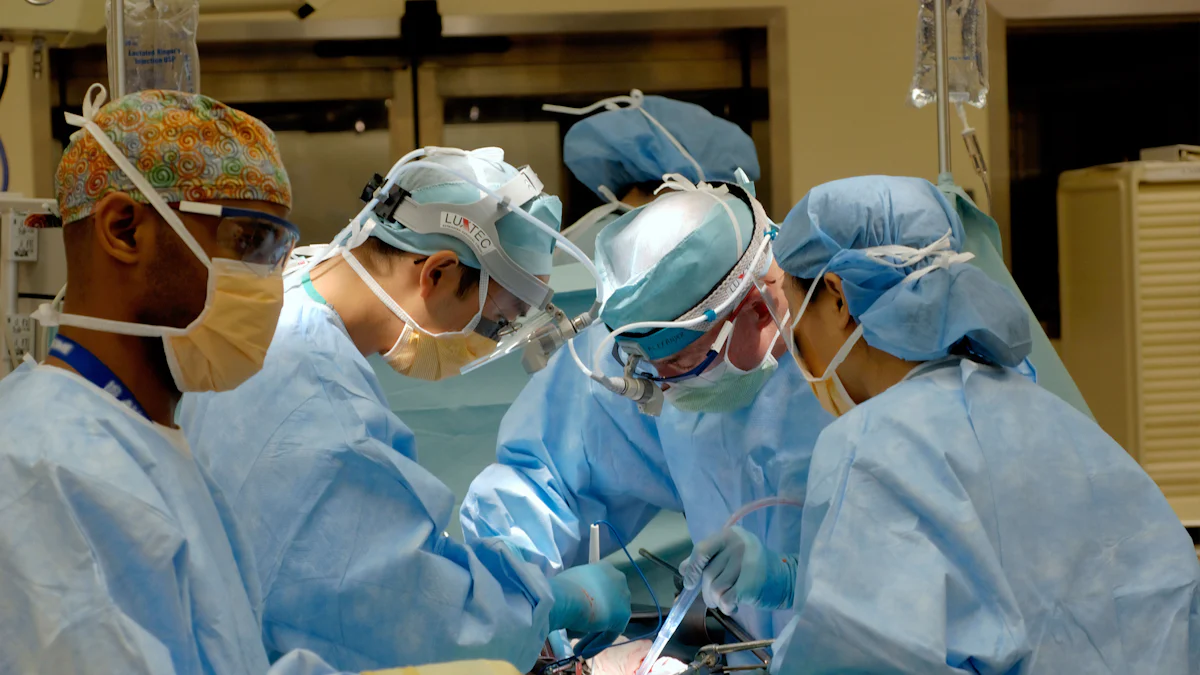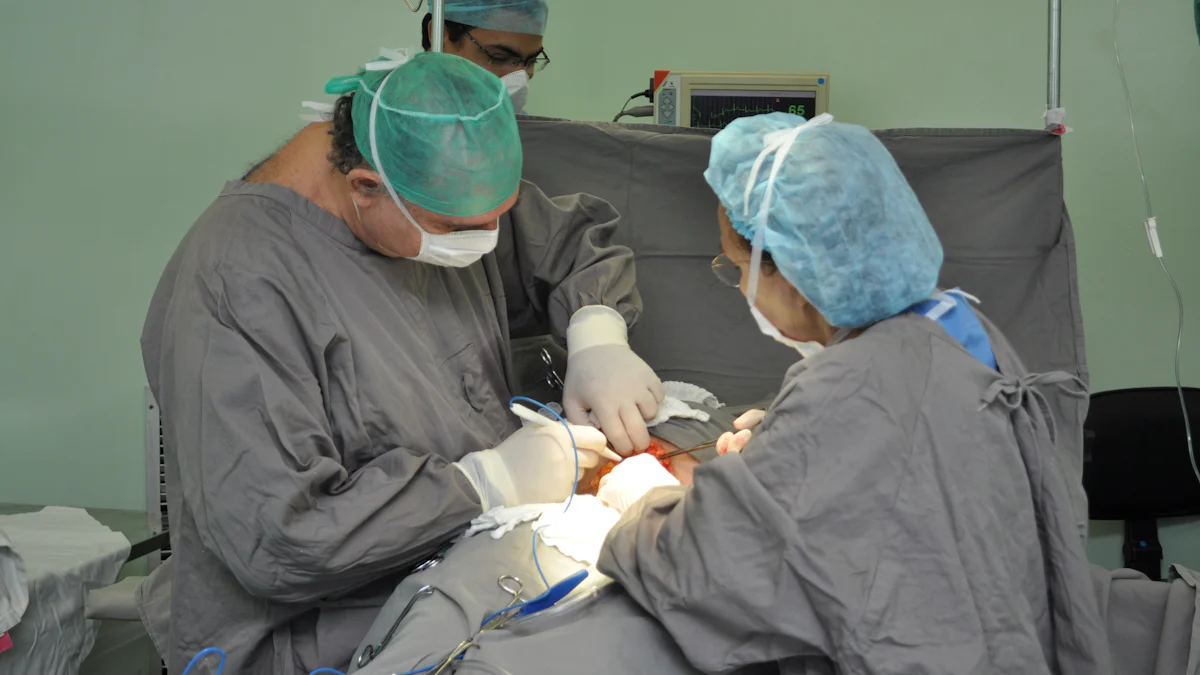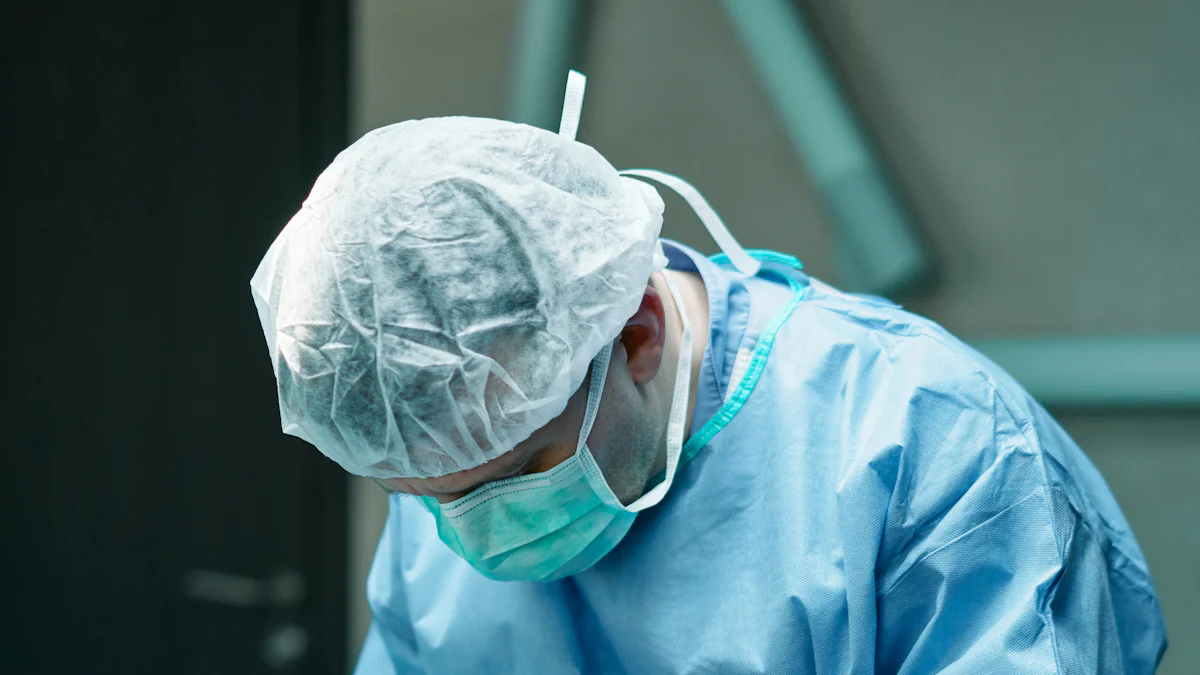The Difference Between Surgical Scrubs Fabric and Medical Scrubs Fabric

When I examine surgical scrubs fabric, I notice its lightweight and non-absorbent nature. This design ensures sterility in operating rooms. In contrast, medical scrub fabric feels thicker and more versatile, offering comfort for long shifts. Medical wear fabric prioritizes durability, while surgical options focus on preventing contamination. Medical uniform fabric must balance practicality with hygiene.
Key Takeaways
- Surgical scrubs are light and don’t soak liquids. They keep operating rooms clean. They are made of polyester-rayon blends to stop germs.
- Medical scrubs are thicker and more useful. They are made of cotton-polyester blends. They focus on being comfy and lasting long for daily work.
- Picking the right fabric is important. Surgical scrubs are for risky areas, while medical scrubs are for regular healthcare jobs.
Material Composition

Fabrics used in surgical scrubs
When I examine surgical scrubs, I notice that manufacturers prioritize materials designed for sterile environments. Most surgical scrubs use a blend of polyester and rayon. Polyester provides durability and resistance to moisture, while rayon adds softness and flexibility. These fabrics are often treated to be lint-free, ensuring no particles contaminate the operating room. I’ve also seen some surgical scrubs incorporate spandex for added stretch, which enhances mobility during long procedures. The lightweight nature of these fabrics ensures comfort without compromising sterility.
Fabrics used in medical scrubs
Medical scrubs, on the other hand, rely on thicker and more versatile materials. Cotton-polyester blends dominate this category. Cotton offers breathability and comfort, while polyester enhances durability and reduces wrinkling. Some medical scrubs also include a small percentage of spandex, which improves flexibility for healthcare workers constantly on the move. I’ve noticed that these fabrics are designed to withstand frequent washing, making them ideal for daily use in non-sterile environments.
Differences in material properties
The differences between these fabrics become clear when I compare their properties. Surgical scrub fabrics are lightweight, non-absorbent, and designed to minimize contamination risks. In contrast, medical scrub fabrics are thicker, more absorbent, and focus on comfort and practicality. Surgical scrubs prioritize sterility, while medical scrubs balance durability and ease of movement. These distinctions highlight how fabric choice aligns with the specific demands of each healthcare role.
Functionality and Purpose
Sterility and protection in surgical scrubs fabric
When I think about surgical scrubs, sterility stands out as their primary purpose. These scrubs use non-absorbent and lint-free fabric to prevent contamination in sterile environments. I’ve noticed that the smooth texture of the material minimizes the risk of particles shedding, which is critical during surgeries. The lightweight design also ensures that healthcare professionals can wear them comfortably under sterile gowns. In my experience, the fabric’s resistance to moisture plays a vital role in protecting against fluid exposure, maintaining a clean and safe operating room.
Versatility and practicality in medical scrubs fabric
Medical scrubs, in contrast, prioritize versatility. I’ve observed that their thicker fabric provides better durability for daily use in various healthcare settings. These scrubs adapt well to different tasks, from patient care to administrative duties. The inclusion of cotton in the material enhances breathability, which is essential for long shifts. I’ve also found that the slight stretch in some medical scrubs allows for greater ease of movement, making them practical for healthcare workers constantly on their feet.
How fabric design supports specific healthcare tasks
The design of scrubs fabric directly supports the demands of healthcare roles. Surgical scrubs focus on sterility and protection, ensuring that the material prevents contamination during high-risk procedures. On the other hand, medical scrubs balance comfort and functionality, enabling healthcare workers to perform diverse tasks efficiently. I’ve seen how the thoughtful selection of fabric enhances both performance and safety, aligning with the unique requirements of each role.
Durability and Maintenance
Durability of surgical scrubs fabric
In my experience, surgical scrubs fabric is designed to withstand the demands of sterile environments. Manufacturers use polyester-rayon blends to ensure durability while maintaining a lightweight structure. These fabrics resist wear and tear caused by frequent use in high-pressure settings. I’ve noticed that surgical scrubs hold up well against repeated sterilization processes, such as autoclaving or high-temperature washing. This resilience ensures that the scrubs remain effective in maintaining sterility over time. However, the lightweight nature of the material means it may not be as robust as thicker fabrics used in other healthcare garments.
Durability of medical scrubs fabric
Medical scrubs fabric, on the other hand, prioritizes long-term durability for daily use. The cotton-polyester blend commonly found in these scrubs provides a balance of strength and comfort. I’ve observed that these scrubs can endure frequent washing cycles without significant fading or shrinking. The thicker fabric also resists pilling and fraying, making it ideal for healthcare workers who need reliable clothing for various tasks. In my opinion, the inclusion of spandex in some designs further enhances the fabric’s ability to retain its shape and flexibility, even after extended use.
Cleaning and care requirements for each fabric type
Proper care is essential to maintain the effectiveness of both types of scrubs. Surgical scrubs require specialized cleaning methods to preserve sterility. I recommend washing them at high temperatures and using hospital-grade disinfectants. These steps ensure that the fabric remains free of contaminants. Medical scrubs, however, are easier to care for. Regular machine washing with mild detergents suffices for most situations. I’ve found that avoiding harsh chemicals and high heat helps prolong the life of the fabric. Following these care guidelines ensures that both types of scrubs perform their intended functions effectively.
Comfort and Practicality

Breathability and fit in surgical scrubs fabric
When I evaluate surgical scrubs, I notice their lightweight fabric enhances breathability. This feature is crucial in operating rooms where healthcare professionals wear multiple layers, including sterile gowns. The polyester-rayon blend used in surgical scrubs allows air circulation, reducing discomfort during long procedures. I’ve also observed that these scrubs are designed with a tailored fit to minimize excess material, which could interfere with sterile practices. The snug yet non-restrictive design ensures that the scrubs stay in place, providing both comfort and practicality in high-pressure environments.
Comfort and ease of movement in medical scrubs fabric
Medical scrubs prioritize comfort and flexibility, which I find essential for healthcare workers who perform diverse tasks. The cotton-polyester blend offers a soft texture against the skin, making it comfortable for extended wear. I’ve noticed that the inclusion of spandex in some designs enhances stretchability, allowing for a full range of motion. This flexibility is particularly beneficial for tasks that require bending, lifting, or prolonged standing. The thicker fabric also provides a sense of durability without compromising comfort, making these scrubs suitable for various healthcare settings.
Balancing comfort and functionality in both fabrics
In my experience, both surgical and medical scrubs strike a balance between comfort and functionality, tailored to their specific purposes. Surgical scrubs focus on maintaining sterility while ensuring the wearer remains comfortable during procedures. Medical scrubs, on the other hand, emphasize versatility and ease of movement, catering to the dynamic nature of general healthcare roles. I’ve found that the thoughtful design of each fabric type supports the unique demands of healthcare professionals, ensuring they can perform their duties effectively without sacrificing comfort.
In my experience, surgical scrubs fabric excels in sterile, high-risk environments. Its lightweight, non-absorbent, and lint-free properties ensure contamination control. Medical scrubs fabric, with its cotton-polyester blend, offers comfort and durability for daily tasks. Choosing the right fabric depends on the role. Surgical scrubs suit operating rooms, while medical scrubs fit general healthcare settings.
FAQ
What makes surgical scrubs fabric lint-free?
Manufacturers treat polyester-rayon blends to prevent shedding. This ensures no particles contaminate sterile environments, maintaining cleanliness during surgeries.
Can medical scrubs fabric handle frequent washing?
Yes, cotton-polyester blends withstand regular washing. Their durability ensures the fabric resists fading, shrinking, and pilling, even after extended use.
Why is spandex included in some scrubs?
Spandex adds stretchability. This improves mobility, allowing healthcare workers to move freely during tasks like bending or lifting.
Post time: Jan-13-2025
